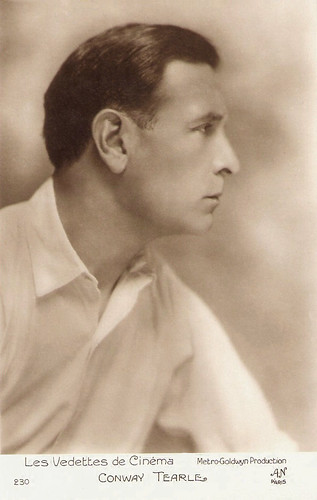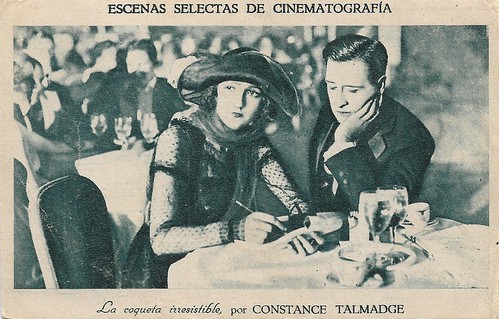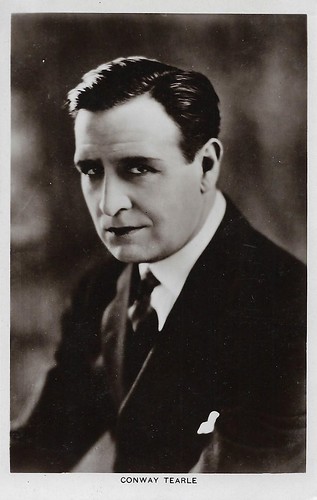
French postcard in the Les vedettes de cinéma series by A.N. Paris, no. 230. Photo: Metro-Goldwyn.

American Arcade card. Photo: Witzel, L.A. Conway Tearle in Marooned Hearts (George Archainbaud, 1920).
The dashing hero or ardent lover
Conway Tearle was born Frederick Conway Levy in 1878 in New York, New York. His parents were Jules Levy, a well-known cornetist and actress Marianne "Minnie" Conway. After Tearle's parents separated, his mother married Osmond Tearle, a British Shakespearean actor popular in 'the provinces'. His maternal half-brother was British actor Godfrey Tearle.
Conway Levy was educated in England and America and took to the stage at an early age. By the age of ten, he could recite twelve Shakespearean plays from memory. Levy took over the stage name Conway Tearle. His big break came at the age of twenty-one when in Manchester, England, without any preparation, he was called upon to play Hamlet after the lead actor took ill just before the first act.
Tearle's performance that night led to his first appearance on the London stage playing the Viscomte de Chauvin, the lead role in 'The Queen's Double' (1901), at the Garrick Theatre. At the beginning of the 1900s, Tearle was on numerous tours in Australia, Ireland and Britain before he made his debut on Broadway in 1905. The great success was denied him, so in 1914, he turned to cinema.
He made his debut alongside Ethel Barrymore in the silent movie drama The Nightingale (1914), written and directed by Augustus Thomas. Over the next few years, Tearle performed in 93 films and for some years he was the highest paid actor in Hollywood. He was often cast as the dashing hero or ardent lover. Tearle made his breakthrough in 1918 alongside Mary Pickford in the drama Stella Maris (Marshall Neilan, 1918).
In 1923, he appeared alongside Pola Negri in her US debut, the romance Bella Donna (George Fitzmaurice, 1923), and in the same year, he appeared alongside Corinne Griffith in Frank Lloyd's fantasy drama Black Oxen (Frank Lloyd, 1923), in which Clara Bow played one of her first roles.

Spanish minicard, series B, no. 19 in the Escenas selectas de cinematografia series by Chocolates Piera y Brugueras, Tarrasa (Barcelona). Constance Talmadge and Conway Tearle in A Virtuous Vamp (David Kirkland, 1919). The Spanish title is La coqueta irresistibile.

Spanish minicard, series A, no. 10 in the Escenas selectas de cinematografia series by Chocolates Piera y Brugueras, Tarrasa (Barcelona). Norma Talmadge and Conway Tearle in The Eternal Flame (Frank Lloyd, 1922).

Spanish minicard in the Escenas selectas de cinematografia series, series B, no. 16. Norma Talmadge and Conway Tearle in The Eternal Flame (Frank Lloyd, 1922).
Dinner at Eight
By that time, Conway Tearle had already passed the zenith of his popularity, but could still demand a $ 2,750 weekday wage. Other memorable titles are A Virtuous Vamp (David Kirkland, 1919) with Constance Talmadge, She Loves and Lies (Chester Withey, 1920) and The Eternal Flame (Frank Lloyd, 1922), both opposite Norma Talmadge.
Later followed such films as Lilies of the Field (John Francis Dillon, 1924) featuring Corinne Griffith, and Dancing Mothers (Herbert Brenon, 1926) starring Clara Bow. The actor easily made the leap into the sound film and played regular supporting roles until his death.
In 1932, Tearle finally had the hoped-for success on stage in the production of 'Dinner at Eight' by George S. Kaufman and Edna Ferber. In the 1933 film adaptation, Dinner at Eight (George Cukor, 1933) his role was taken over by John Barrymore. Both actors played together in Cukor's Shakespeare film adaptation Romeo and Juliet (George Cukor, 1936), starring Norma Shearer and Leslie Howard.
Conway Tearle was married four times. His third wife, Roberta Hill, filed for a divorce in 1916 after detectives she hired found him in a hotel room with Adele Rowland, a musical-comedy actress and singer. The two claimed they were just rehearsing a play. Tearle and Rowland wed in 1918 and remained together until his death.
Conway Tearle died in 1938 in Los Angeles at the age of 60 years of a heart attack, after he had already withdrawn from the acting business the year before because of health problems.

British postcard in the Picturegoer Series, London, no. 26a.

German postcard by Verlag Ross, Berlin, no. 1186/1, 1927-1928. Photo: First National.
Source: Wikipedia (German and English), and IMDb.
No comments:
Post a Comment